Rooftop bars are proliferating in San Francisco these days, whether the 2017 opening of Charmaine’s at the San Francisco Proper, or 2022’s Rise Over Run at the Line San Francisco, and KAIYŌ Rooftop atop the Hyatt Place Hotel. The latter is a sister restaurant/bar to brand new Cavaña, which just opened late January 2023 on the 17th floor of the LUMA Hotel San Francisco.
A stones’ throw from the SF Giants’ Oracle Park, you can hear the ballpark (and at times, concerts) din buzzing nearby as you take in stunning city views of blazing sunsets behind Twin Peaks and the Sutro Tower from the south patio with outdoor bar, to the more chill, fireside glow of downtown SF and the Bay Bridge on Cavaña’s north and east sides.
Yes, views are worth coming for alone… if you can get in (peeps just can’t get enough rooftop bars). It’s already booked up with lines out the door within the first month, thankfully with a dedicated elevator to whisk people up and down. Cavaña immediately stands apart from some new rooftop bars with its festive Latin vibe and menus that veer from Mexico, all the way south to Peru, back up through Brazil and Argentina, by way of Venezuela, with the Caribbean thrown in for good measure.
You’ll taste these influences in the cocktails and dishes, as you will hear it in the fab playlist that swings from the Mexican garage rockabilly vibes of Los Apson, to the hip sounds of Bronx River Parkway; the smooth ‘70’s stylings of Brazilian singer Rosa Maria, to the experimental Peruvian, Colombian, Venezuelan and New York sounds of La Mecánica Popular; even the Italian 1960s-80s ease of singer-songwriters Fabrizio De André and Franco Battiato. I could stay festive into the night with the playlist alone, but they also host DJs and live musicians, confirming Cavaña’s music-centric spirit.
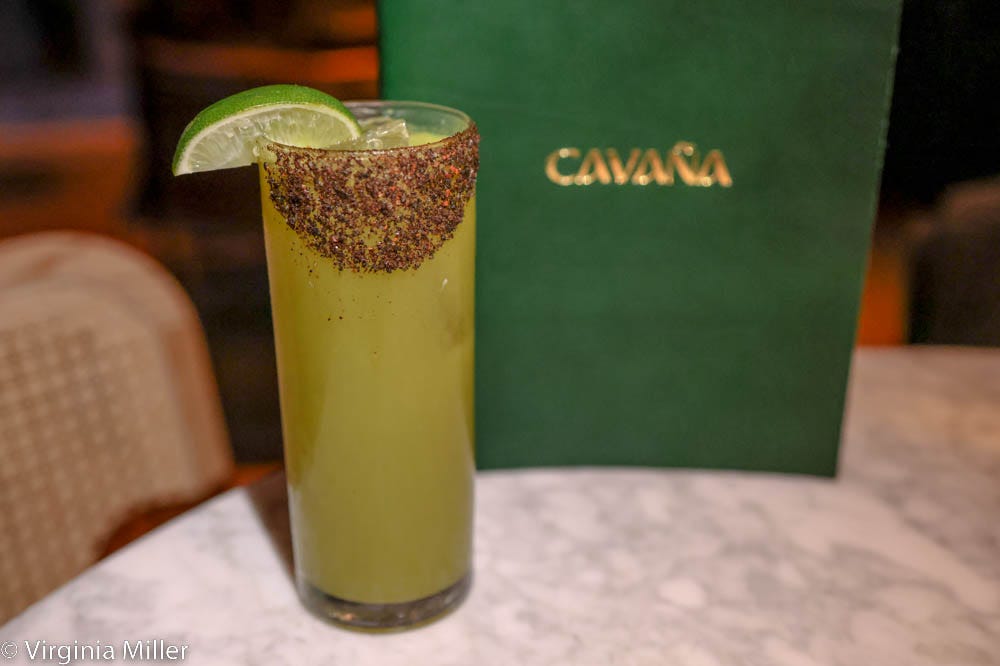
It gets noisy here, even as tables indoors are nicely spread apart, benefitting from open air doorways to patios on three sides with more neutral colored couches and chairs. Rich dark greens complement tan and cream accents and wallpaper-ed ceilings indoors, contrasted by Irving Herrera’s striking woodblock prints and the Bay Area’s Brie Wolf with Oaxaca’s Ana Martinez’ handcrafted ceramics.
The quality of the menu and experience is confirmed when you know who is behind it: restaurateur John Park of BXB Hospitality, which runs the aforementioned KAIYŌ Rooftop, KAIYŌ, Whitechapel and Novela; Peruvian chef Alex Reccio, also behind KAIYŌ Rooftop’s food; and three powerhouse drink industry bartenders and managers: managing partner Anthony Parks (from the likes of True Laurel, Whitechapel and Mourad) and beverage director Emilio Salehi and bar manager Miguel Salehi (both formerly running Beehive). The brothers have been exploring their Venezuelan heritage in the context of Latin America on their tight cocktail menu.
Cavaña is a bar first, but one with plenty of food. There is the expected: guacamole, but amped up with rainbow radishes and pepitas, or oysters, but vivid in leche de tigre sauce. The Central and South America cross section shows in two styles of aguachile (“chile water”), whether a cured white fish version touched with cucumber, green apples, cilantro, lime and avocado, or Gulf prawns, bright with tomato, hoja santo (Mexican pepperleaf), serrano chili, lime and avocado.
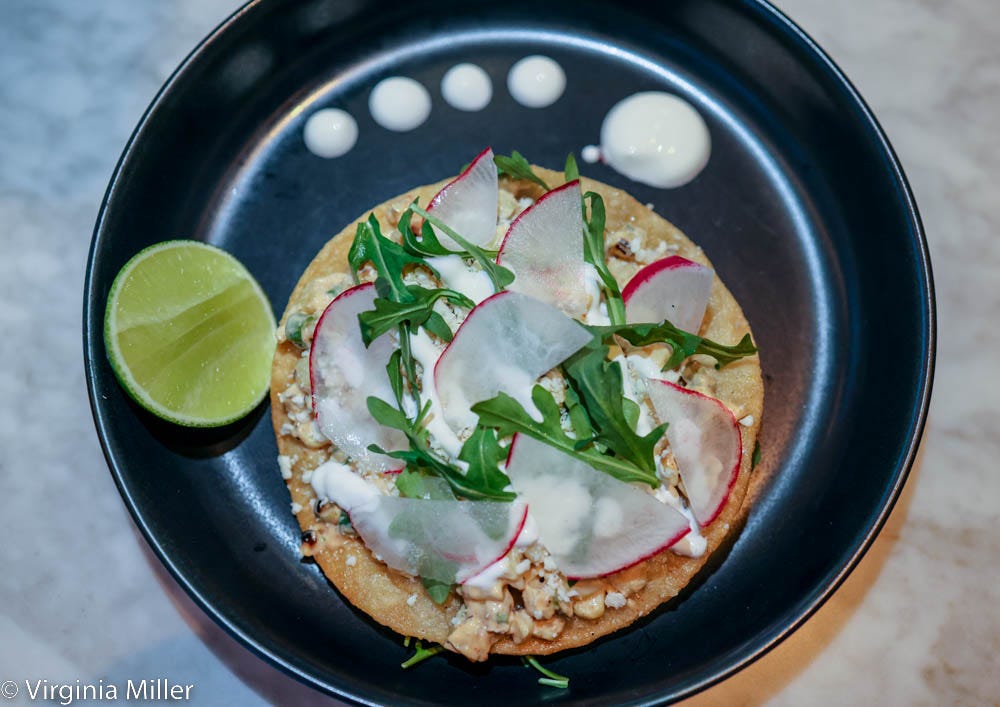
Maybe the best bite of the night was an esquites tostada: the crispy tortilla round layered with sweet corn in crema, crumbly queso fresco cheese, dried chiles and pico de gallo salsa. It captures the creaminess of classic Mexican esquites tempered by the tostada crunch. The other runner up is a spot-on arepas de pabellón, the national dish of Venezuela. The maize dough of the savory white corn “cakes” cradle brisket stew, black beans, peppers and cotija cheese in a little sandwich where the arepa itself outshines the meat.
Sadly, we ordered pastel de carne — Brazilian flaky pastries packed with braised beef, dipped in rocoto aioli — but when it was supposed to come out, the kitchen ran out. We opted for costillar de res (slow roasted beef short ribs) is a dish you find variations of from Mexico to Colombia. This rendition sports Argentinean chimichurri sauce with broccolini, a solid dish but maybe my least favorite of the night given a very light smattering of sauce and a couple gristly parts of the rib.
Bolinhos de bacalhau is ever a traditional Portuguese favorite of mine, also popular in Brazil given the country’s deep Portuguese background. These are quality salt cod fritters laced with (non-spicy) orange peppers, dipped in a lively tartar sauce. You may be catching the drift: this is drinking food, ideal for grazing and sharing, but easy to fill up on if you want a full meal.
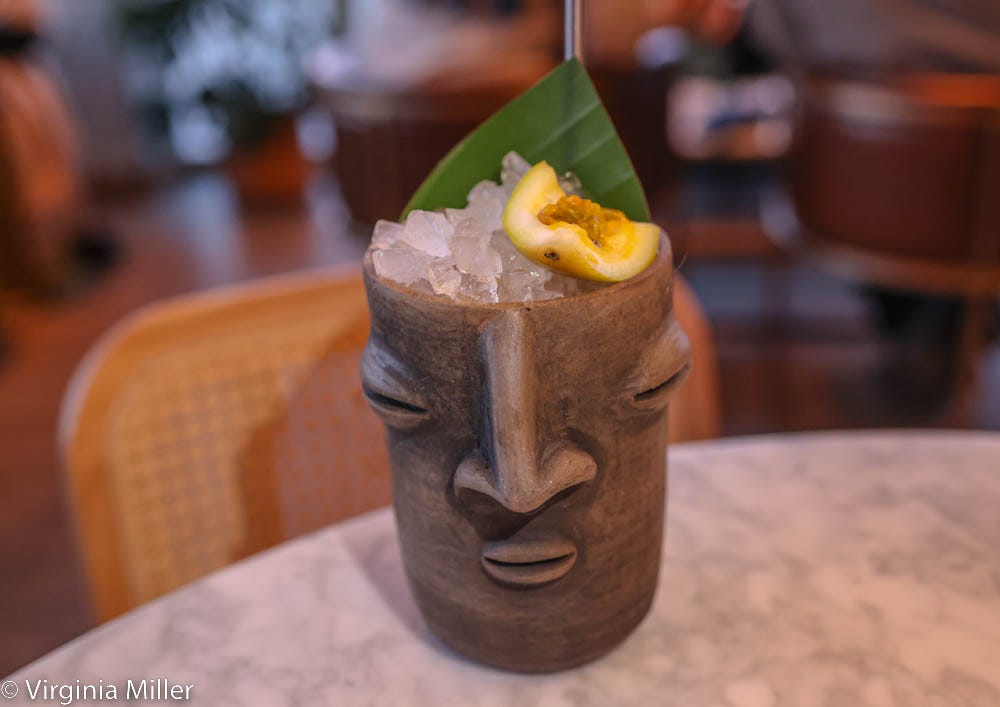
But the menus really do center around the cocktails. Immediately, a pricier ($20) Caña Parchita is my favorite, pricier given its bold blend of spirits, including Oaxacan rum and aguardiente with Bajan rum, passionfruit, coconut, ancho chiles and lime. It’s served in a handmade ceramic mug the Salehi brothers found while traveling and researching in Oaxaca recently from a female producer, the aforementioned Ana Martinez. Very small production and hard to get to the states, these mugs signify the kind of care and research behind the Salehi’s drink menus.
So does their use of the Mexican herb hoja santa. They harvest it here in the Mission District from a woman’s tree/plant grown with a cutting from none other than Diana Kennedy’s Mexico garden, the Mexican food cookbook pioneer to the English-speaking world. The Salehi’s clarified milk punch, Kiwi Hoja, sports a mixed base of Singani Bolivian brandy and mezcal, silky and sweet with kiwi, lime, clarified milk and peppery, green hoja santa. In the opening couple weeks, it has been the most popular drink and given its sweet approachability, I can see why.
Refreshers include the Melón Salvia (Brazilian cachaça, blanco tequila, sage wine, cantaloupe, lemon, Chareau aloe vera liqueur) or the stiffer — read: boozier, served up in a coupe glass — Papaya Uva (Peruvian pisco acholado, papaya, grapefruit, elderflower, Meyer lemon). I sampled their delightful house chicha morada, Peru’s spiced purple corn juice, which you can order non-alcoholic on its own or in the Chicha Tonica with charanda (Michoacán Mexican sugarcane spirit), smoked pineapple, ginger, lime, tonic.
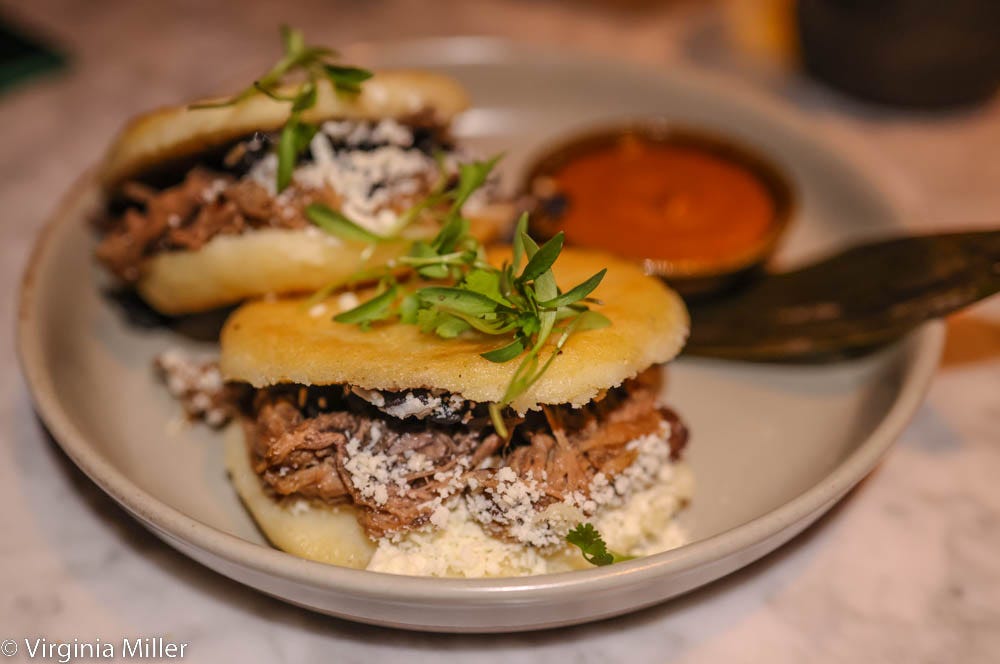
But the other standouts of eight drinks I tasted included Sangrita Chela featuring their fab sangrita verde, a traditional green-pineapple-chile-cilantro-savory juice. Here, it’s served tall on the rocks with blanco tequila, mezcal espadin, a spritz of Occidental Brewing Co. Cerveza Clara lager beer and a poblano salt rim. It’s an all-day crushable kind of drink.
On the opposite end of the spectrum, the Elote Pasilla is the spirituous entry featuring ever-popular-these-days Abasolo Mexican corn whiskey, reposado tequila, pasilla chiles, bitter vermouth and the very smart addition of blackened corn. They smoke the corn on the cob in-house, infusing it in the whiskey, blessedly amping up the corn factor with gently smoky, char notes. It’s nicely integrated and balanced, yet maintaining robustness.
My biggest surprise was their Caipirinha, Brazil’s national cocktail. In the menu, they feature a rotating classic cocktail with classic postcard art — where you’ll find rum, pisco and agave Latin classics, like mojitos or pisco sours. I’ve tasted hundreds upon hundreds of Caipirinhas over the past 20 years (and can make a mean one at home). It’s akin to a Daiquiri or Margarita in its classic simplicity of cachaça (Brazilian sugarcane spirit), sugar and lime. So I was not about to order one, rather focused on house creations. Thankfully, the Salehi brothers brought us one to sample.
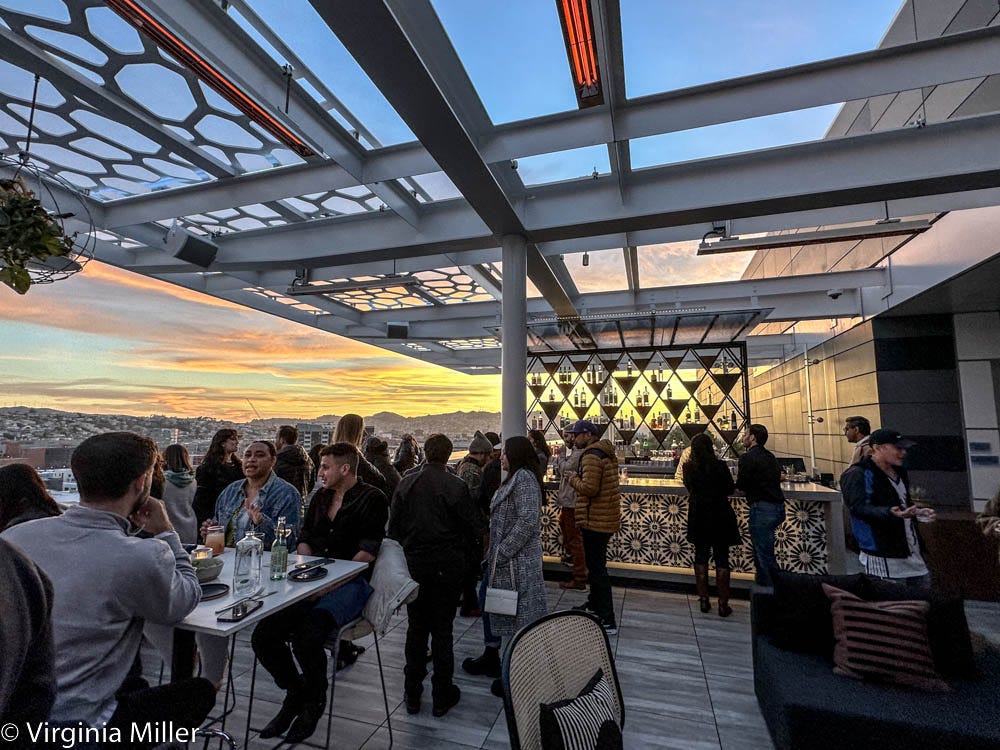
The Salehi’s Caipirinha immediately reminded me of a Ti Punch, the island of Martinique’s equally simple but perfect classic cocktail, showcasing my beloved rhum agricole, the grassy, funky, beautiful, sugarcane-only rum. Like agricole, cachaça is grassy, green, breezy. But Caipirinhas or classic Daiquiris are juicer with more lime, whereas a Ti Punch is boozier, with the oils and essence of lime with a lime wedge vs. squeezed juice. Emilio and Miguel do a similar thing with their Caipirinha: lime peel essence and oils with just a touch of juice let the cachaça shine with the right amount of sugar, smartly served on crushed ice so it still tastes refreshing instead of drinking like a boozy sipper. It’s arguably the best Caipirinha in the city.
I’m craving their Caipirinha again — a rare comment from someone who typically avoids the classics after over 22 years of researching in thousands of the world’s best bars and restaurants, often making better versions at home. It’s hard to impress me with a classic cocktail when I’ve tasted many thousands (literally) of the best and a large portion of those are similar and “fine” but don’t necessarily tell me what a bartender is about.
Rounding out the drink options: there’s bottle service focused around mezcals, tequilas and rums served with fruits, juices/aguas frescas and accompanying elements, while wines range from across California and Latin America, including some Mexican wines.
While I wouldn’t outright call Cavaña a notable food destination, the food is certainly good. With stellar views, service from the likes of John Park and Anthony Parks and the Salehi’s thoughtful drink menu, it’s a quality rooftop bar many cities would be lucky to have as most often views come with utter mediocrity on the menus. Unfortunately, Cavaña already is a tough ticket, but the patient can wait in line, while reservations thankfully are also an option. See you up there as we toast a glorious SF sunset with a Caipirinha.
// Luma Hotel San Francisco, 100 Channel Street, www.cavanasf.com







